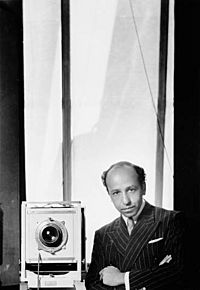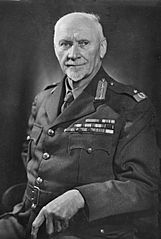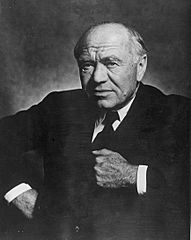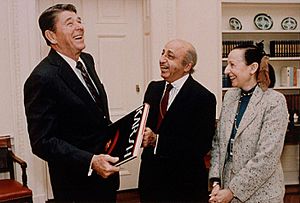Yousuf Karsh facts for kids
Quick facts for kids
Yousuf Karsh
CC RCA FRPS
|
|
|---|---|
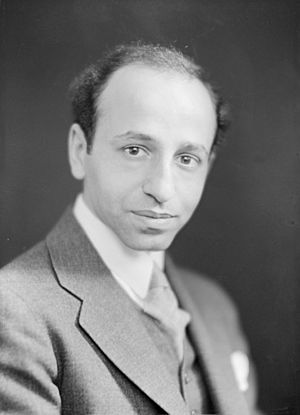
Karsh in 1936, by Joseph-Alexandre Castonguay
|
|
| Born | December 23, 1908 Mardin, Ottoman Empire (present-day Turkey)
|
| Died | July 13, 2002 (aged 93) Boston, Massachusetts, U.S.
|
| Burial place | Notre-Dame Cemetery |
| Nationality | Canadian |
| Spouse(s) |
|
| Signature | |
Yousuf Karsh (December 23, 1908 – July 13, 2002) was a famous Canadian photographer. He was especially known for taking amazing portraits of important people. Many say he was one of the greatest portrait photographers of the 20th century.
Karsh came to Canada as a refugee after facing difficult times in his home country. By the 1930s, he became a well-known photographer in Ottawa. He lived there for most of his life, but he traveled a lot for his work.
A very famous photo he took was of Winston Churchill in 1941. This picture helped make his 60-year career a huge success. He photographed many famous leaders, artists, scientists, and more. Over 20 of his photos were featured on the cover of Life magazine. He stopped working in 1993.
Contents
Early Life and Move to Canada
Yousuf Karsh was born on December 23, 1908, in Mardin, a city in what was then the Ottoman Empire (now Turkey). His parents were Amsih Karsh and Bahia Nakash. He had two brothers, Jamil and Malak, who also became a photographer.
When he was young, his family faced very hard times. Some of his family members were killed. Karsh later wrote that his memories of those days were a mix of "blood and beauty, of persecution and peace." In 1922, Karsh and his family had to escape to a refugee camp in Aleppo, Syria. Their journey took a whole month.
Karsh was sent to Canada by his family for a new start. He arrived in Halifax, Nova Scotia on December 31, 1923. From there, he moved to Sherbrooke, Quebec, to live with his uncle, George Nakashian. His uncle was also a portrait photographer.
When Karsh first arrived, he spoke very little English or French. He had no money and not much schooling. He worked for his uncle, who taught him photography. His uncle even gave him a simple Box Brownie camera. From 1928 to 1931, Karsh learned more about photography in Boston, Massachusetts. He worked for John H. Garo, a famous Armenian photographer.
Karsh's Photography Career
Karsh settled in Ottawa and opened his first photography studio in 1932. It was located on Sparks Street. Later, in 1972, he moved his studio to the famous Château Laurier hotel. He became known as "Karsh of Ottawa," which was also how he signed his photos.
He became successful when Canadian Prime Minister William Lyon Mackenzie King noticed his work. The Prime Minister helped Karsh arrange photo sessions with important visitors. Karsh also took pictures of the Governor General and his wife, which were published widely.
Karsh photographed "anyone who was anyone." When people asked why he only took pictures of famous people, he said, "I am working with the world's most remarkable cross-section of people." He believed that a small group of people really make the world go round. He even joked that he did it for his "own immortality." By the time he retired in 1992, over 20 of his photos had been on the cover of Life magazine.
Karsh's photos were known for their dramatic lighting. This special way of using light became his signature style. He learned about lighting from his mentor in Boston and at the Ottawa Little Theatre. Before taking a picture, Karsh would research his subjects and talk to them to understand them better.
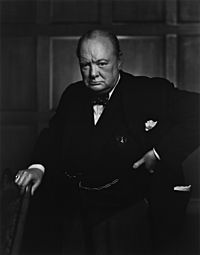
His 1941 photo of Winston Churchill, the British Prime Minister, made him famous around the world. The picture was taken on December 30, 1941, in the Canadian Parliament in Ottawa. Churchill had just given a speech about World War II.
The photo session was very quick. Just before taking the picture, Karsh walked up to Churchill and took the cigar out of his mouth. Churchill was not happy about this, and his annoyed expression was captured in the portrait. This picture, called The Roaring Lion, became a symbol of Britain's strength during the war.
The Economist newspaper called it the "most reproduced portrait in the history of photography." It appeared on the cover of Life magazine in 1945. A print of the original photo hangs in the Canadian Parliament where it was taken. It is also on the Bank of England £5 note.
In 2022, a Karsh-signed portrait of Churchill was stolen from the Château Laurier in Ottawa and replaced with a fake. Hotel staff noticed the frame didn't match other Karsh portraits. The director of Karsh's estate confirmed the signature was fake. Police are investigating the theft.
During World War II, Karsh photographed many political and military leaders. After the war, he started taking pictures of writers, actors, artists, musicians, scientists, and other celebrities. His 1957 portrait of American novelist Ernest Hemingway is another famous photo. It made Hemingway look like the hero from his book The Old Man and the Sea.
Other famous people he photographed include George Bernard Shaw (1943), Dwight D. Eisenhower (1946), American artist Georgia O'Keeffe (1956), and Soviet leader Nikita Khrushchev (1963).
Besides famous people, Karsh also photographed factory workers in Windsor, Ontario, for the Ford Motor Company of Canada. He also took pictures of landscapes in Rome and the Holy Land for books.
Karsh closed his studio in June 1992. His last photo sessions were in May 1993, when he photographed President Bill Clinton and First Lady Hillary.
Gallery of Works
Personal Life
Karsh's first wife was Solange Gauthier. They married in 1939. She was an actress he met at the Ottawa Little Theatre. They lived in an Art Deco home called Little Wings near the Rideau River. Solange passed away in 1961.
In 1962, he married Estrellita Maria Nachbar, a medical writer. From 1972 to 1992, they lived in a suite at the Château Laurier hotel in Ottawa. They also kept their home, Little Wings, and an apartment in Manhattan. They did not have any children.
Retirement and Death
Karsh moved to Boston in 1997. He passed away on July 13, 2002, in Boston after surgery. A private funeral was held in Ottawa, and he was buried in Notre-Dame Cemetery.
Recognition and Legacy
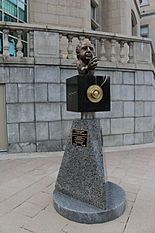
Yousuf Karsh is known as Canada's top portrait photographer. He is also recognized as one of the most famous and greatest portrait photographers of the 20th century worldwide.
The Governor General of Canada's website calls him the "pre-eminent portrait photographer of the twentieth century." The Metropolitan Museum of Art said he had a special style with his dramatic lighting. The Canadian Encyclopedia noted that his portraits became the public images of many important people in politics, science, and culture.
His work is displayed in many famous museums around the world. These include the Metropolitan Museum of Art and the Museum of Modern Art in New York, and the National Gallery of Canada.
In 1987, the National Archives of Canada received Karsh's complete collection. This includes all his negatives, prints, and transparencies since 1933. The collection has 355,000 items. Karsh's wife, Estrellita, also gave over 100 photos to the National Portrait Gallery in Washington, D.C.
Karsh was a member of the Royal Canadian Academy of Arts. He was also an honorary member of the Royal Photographic Society in the UK.
On June 9, 2017, a statue (bust) of Karsh was put in front of the Château Laurier in Ottawa. It was a gift from Armenia to Canada. The statue shows Karsh with his famous camera.
The Karsh Award is given every two years by the City of Ottawa. It honors Yousuf and his brother Malak Karsh. The award goes to a professional artist for excellent photo-based artwork.
Awards and Honors
- Golden Plate Award of the American Academy of Achievement (1961)
- Order of Canada: Officer (1967), Companion (1990)
- Canada Council Medal (1965)
- Achievement and Life Award, Encyclopædia Britannica (1980)
- Gold Medal of Merit, National Society of Arts and Letters (1991)
Karsh also received honorary degrees from many universities, including Dartmouth College, Ohio University, Tufts University, and Syracuse University.
He has been added to the International Photography Hall of Fame and Museum.
See also
 In Spanish: Yousuf Karsh para niños
In Spanish: Yousuf Karsh para niños


